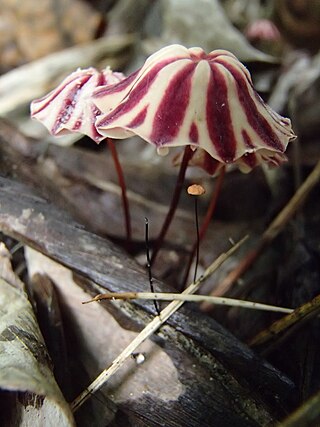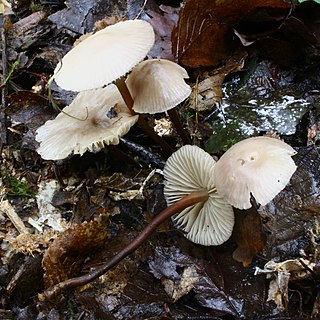Marasmius tenuissimus is a species of agaric fungus in the large agaric genus Marasmius.
Epicnaphus is a genus of mushroom-forming fungi in the family Marasmiaceae. The genus, circumscribed by mycologist Rolf Singer in 1960, contains two species found in South America. Fruitbodies of Epicnaphus species are similar in appearance to those in Marasmius section Sicci, but have a smooth hymenium and broom cells of the Rotalis-type. Singer initially included only the type species, E. phalaropus, which was originally collected from fallen branches in a Bolivian rainforest. The Argentinian species E. longispora was added to the genus by Jörg Raithelhuber in 1973.

Mycetinis is a genus of fungus in the Omphalotaceae family, containing about eight species formerly classified in Marasmius.

Marasmius elegans, commonly known as the velvet parachute, is a species of fungus in the family Marasmiaceae. It has a reddish-brown cap, and a whitish stipe with white hairs at the base. It can be found in eucalypt forests in Australia.

Marasmius rotula is a common species of agaric fungus in the family Marasmiaceae. Widespread in the Northern Hemisphere, it is commonly known variously as the pinwheel mushroom, the pinwheel marasmius, the little wheel, the collared parachute, or the horse hair fungus. The type species of the genus Marasmius, M. rotula was first described scientifically in 1772 by mycologist Giovanni Antonio Scopoli and assigned its current name in 1838 by Elias Fries.

Marasmius sasicola is a species of Marasmiaceae fungus known from Kanagawa Prefecture, Japan. First collected in 2000, it was described in 2002 by Haruki Takahashi. The species produces small mushrooms with white caps and very short, very thin black stems. Unlike in other, similar species, the stems enter the plant matter on which the mushroom grows. The six to eight white gills are spread out around the cap, and all of them reach the stem. The flesh has no taste or odour. Found in June, the species grows on dead Sasa leaves, from which it takes its specific epithet.

Marasmius funalis is a species of Marasmiaceae fungus known only from Japan. The species produces small mushrooms with reddish-brown caps up to 6 millimetres (0.24 in) in diameter and dark-brown, threadlike stems of up to 50 millimetres (2.0 in) in length. The species has a number of distinctive microscopic features, including very long cystidia on the stem, visible as bristles. Described in 2002 by Haruki Takahashi, the species grows on dead wood. The closest relative of M. funalis is M. liquidambari, known from Mexico and Papua New Guinea, and it is also similar in appearance to M. hudonii and Setulipes funaliformis, the latter of which was named after M. funalis.

Marasmius koae is a species of agaric fungus in the family Marasmiaceae. Newly described to science in 2011, it is known only from Hawaiian montane wet forests. It produces small stemless fruit bodies that grow on the rotting wood of the flowering tree koa.

Marasmius capillaris is a species of agaric fungus in the family Marasmiaceae. A saprobic fungus, it produces fruit bodies (mushrooms) that grows in groups on decaying oak leaves in North America. The caps on the mushrooms are convex and then centrally depressed with radial furrows, measuring 2–15 mm (0.08–0.6 in) in diameter. The wiry, shiny stems are thin and up to 60 mm (2.4 in) long. Its spore print is white, and the spores are smooth and pip-shaped, measuring 7–11 by 3–5 μm. The mushrooms somewhat resemble Marasmius rotula, but are smaller and darker in color.

Marasmius bulliardii is a species of agaric fungus in the family Marasmiaceae. It was first described scientifically by French mycologist Lucien Quélet in 1878.

Marasmius fulvoferrugineus is a species of agaric fungus in the family Marasmiaceae. Described as new to science in 1976, it is found in the southeastern United States. The mushroom is frequently confused with Marasmius siccus, and microscopy is needed to reliably distinguish between them.
Marasmius asiaticus is a species of agaric fungus in the family Marasmiaceae. Within the large genus Marasmius, it is classified in section Sicci. Known only from a single collection made in Mount Nuang Forest Reserve, it was described as new to science in 2009 by Tan and Dennis Desjardin under the name Marasmius distantifolius. This was later discovered to be an illegitimate homonym of a species named by William Alphonso Murrill in 1915, now known as Marasmiellus distantifolius. Armin Mešić and Zdenko Tkalčec proposed the new epithet asiaticus, referring to its distribution. The original epithet, which combined the Latin distans ("distant") and -folius ("leaf"), alluded to the distantly-spaced gills.
Marasmius aporpus is a species of fungus in the large agaric genus Marasmius. Found in Chile, it was described as new to science in 1969 by mycologist Rolf Singer.
Marasmius lomatiae is a species of fungus in the large agaric genus Marasmius. It is found in Argentina, where it grows on the dead leaves of Lomatia, Luma and Nothofagus species. The fungus was described as new to science in 1969 by mycologist Rolf Singer.
Marasmius pacificus is a species of fungus in the large agaric genus Marasmius. It is found in Chile, where it grows on the fallen leaves of Aextoxicon, Laurelia, and Myrtaceae. The fungus was described as new to science in 1969 by mycologist Rolf Singer.
Marasmius valdivianus is a species of fungus in the large agaric genus Marasmius. Found in Chile, the fungus was described as new to science in 1969 by mycologist Rolf Singer.

Marasmius tageticolor is a species of agaric fungus in the family Marasmiaceae. Its fruit bodies have striped red and white caps. It is found in Mexico, Central America, and South America, where it grows on twigs.

Rhizomarasmius setosus is a tiny whitish mushroom having a distinctive hairy stem. It has been given the vernacular name "Beechleaf Parachute".

Marasmius wynneae is a species of gilled mushroom found in European woods.










